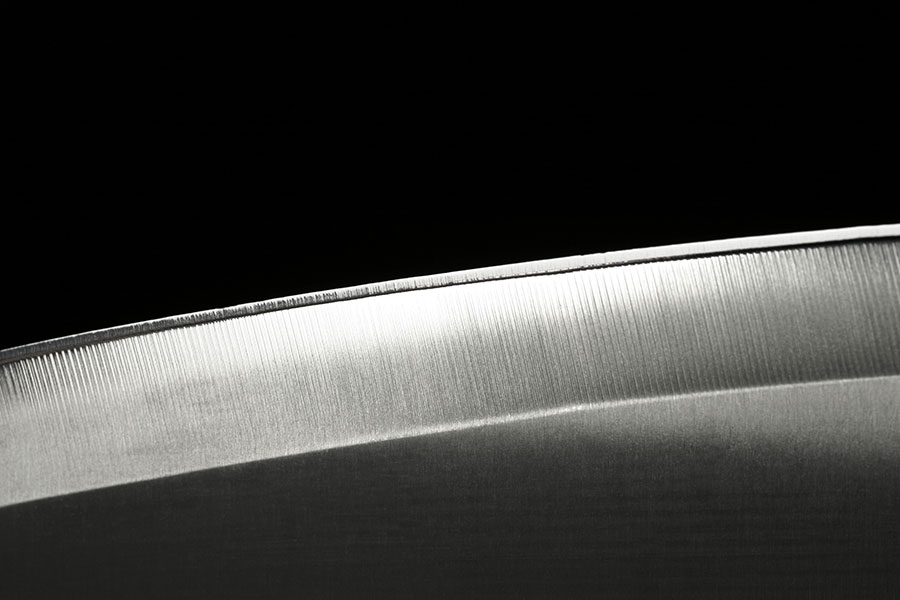Find the “universal kitchen gadget” that’s perfect for you
The knife is arguably the most important tool in the kitchen. “It’s an extension of your hand when you’re working,” says Kris Armitage (Culinary Arts ’02), manager of Knifewear Edmonton, a shop that specializes in high-performance Japanese kitchen knives.
“It’s the universal kitchen gadget.”
Armitage, who was a professional chef for seven years, says he sees more people – both chefs and home cooks – coming in to buy a quality knife. As greater attention turns to using fresh, local and organic ingredients, more emphasis is being put on the quality of tools used to handle them.
With hundreds of knife styles available, how do you know what to choose? Here, Armitage sharpens our knowledge of knives so we can cook easier, safer and better.
Steel is the secret

Steel is the key to knife quality. The harder the steel, the longer the edge will stay sharp – and, generally, the more expensive the knife.
It’s also the key to great cooking, says Armitage. Using dull knives on food can cause the ingredient to retain less flavour. “It can definitely change the way your food tastes.”
For example, thinly slicing garlic with a very sharp blade produces a sweeter flavour, while mincing garlic gives you a spicier, more intense flavour.
The two knives you really need
Armitage recommends a multi-purpose “chef’s knife.” Long and flat – anywhere from 18 to 36 centimetres (seven to 14 inches) long, with most being 21 cm (8.25 inches) – it’s perfect for fruits, vegetables or meat.
“This is the style of knife most [Western] chefs use for 90% of their work,” Armitage says. “I’ve used mine for everything from carving a roast to coring strawberries.”
As well, many home cooks will have petty, or utility, knives, which range from 9.5 to 15 cm (3.75 to 6 inches). Use them for small jobs on a cutting board.
Baby your knives
Wash your knives by hand rather than in the dishwasher. “The heat can damage the tempering of the steel and will quickly break down the handle,” says Armitage. Dry them off with a towel to prevent rusting, which can affect even the finest knives over time.
Use a honing rod every time you pick up your knife. Over time, the steel on the thin edge of the blade rolls back and forth and becomes dull. Running both sides of the blade across the rod at an angle of 15 to 25 degrees (press the knife’s flat edge to the middle of your thumb, then the side of your thumb against the rod) will straighten that edge. You’ll need to sharpen it less frequently as a result.
Knife sharpening 101
Watch as Professional Meatcutting and Merchandising instructor Mark Trick (Culinary Arts ’08, Retail Meatcutting ’84) takes us through the motions of putting an edge back on your favourite blade.
If you’re using a honing rod, you shouldn’t need to do this often. But if you need to force the knife into the cut regardless (which can cause dangerous slipping), it’s time for a sharpening.
Cost of a good knife
Armitage prefers Japanese knives (Knifewear’s specialty) for their hardness of steel and slimness, which produces precise, smooth cuts. You can spend anywhere from $100 to $900 on these.
For the home cook, Armitage says an investment starting at about $150 will likely do the job. For that price, you’ll get a handcrafted product that will last a lifetime and give you a serious edge in the kitchen.
Banner image Arthur_Dent/istockphoto.com
7 great knives recommended by a NAIT chef
“I think buying knives can be similar to buying automotive tools,” says Perry Michetti (Cooking ’90), Culinary Arts and professional food studies department head. “For the person who pulls out a wrench once every three months to tighten a simple bolt, just about anything will do.
“But if you are twisting those things every day, the balance and feel of a high-quality wrench is worth spending the money on.”
Here are a few of Michetti’s favourites – ranging from just over $60 (#1) to more than $700 (#7) – for the casual to passionate home cook, as well as the seasoned pro.
- Victorinox Fibrox Pro 8” Chef’s Knife – A great knife that’s easy to handle and sharpen, and has a good edge. “We sell these to our students as part of their kit,” says Michetti.
- F. Dick Superior Chef Knife 8.5” – Features a good quality blade at a reasonable price. A great starter for students.
- Victorinox Grand Maître Santoku – A Japanese version of an all-purpose kitchen knife. Ergonomic, well balanced and reasonably priced.
- Wusthof 8” Classic Wide Chef Knife – “I own this one and it is my wife’s absolutely favourite,” says Michetti. Tough yet versatile.
- Kasumi 10” Damascus Chef Knife – This Japanese-made knife features high-quality, multi-layered steel and a comfortable wood-plastic handle. Michetti owns two of them.
- F. Dick 1778 Santoku 7” Knife – This, says Michetti, is made by a “very good knife company.” The price reflects the quality, defined by remarkable sharpness and balance.
- Swiss Modern Santoku Damast LE – As stunning to look at as it is to work with, this ranks among Michetti’s “dream” knives. “You would need to learn how to sharpen this one on a Japanese water stone,” he points out.